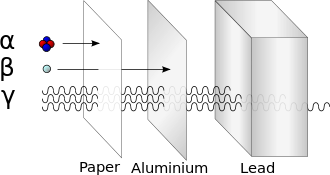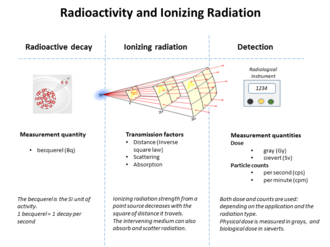In physics, radiation is the emission or transmission of energy in the form of waves or particles through space or through a material medium. [1][2] This includes:
- electromagnetic radiation, such as radio waves, microwaves, infrared, visible light, ultraviolet, x-rays, and gamma radiation (γ)
- particle radiation, such as alpha radiation (α), beta radiation (β), proton radiation and neutron radiation (particles of non-zero rest energy)
- acoustic radiation, such as ultrasound, sound, and seismic waves (dependent on a physical transmission medium)
- gravitational radiation, radiation that takes the form of gravitational waves, or ripples in the curvature of spacetime
Radiation is often categorized as either ionizing or non-ionizing depending on the energy of the radiated particles. Ionizing radiation carries more than 10 eV, which is enough to ionize atoms and molecules and break chemical bonds.
https://en.wikipedia.org/wiki/Radiation
Gamma rays, X-rays and the higher energy range of ultraviolet light constitute the ionizing part of the electromagnetic spectrum. The word "ionize" refers to the breaking of one or more electrons away from an atom, an action that requires the relatively high energies that these electromagnetic waves supply. Further down the spectrum, the non-ionizing lower energies of the lower ultraviolet spectrum cannot ionize atoms, but can disrupt the inter-atomic bonds which form molecules, thereby breaking down molecules rather than atoms; a good example of this is sunburn caused by long-wavelength solar ultraviolet. The waves of longer wavelength than UV in visible light, infrared and microwave frequencies cannot break bonds but can cause vibrations in the bonds which are sensed as heat. Radio wavelengths and below generally are not regarded as harmful to biological systems. These are not sharp delineations of the energies; there is some overlap in the effects of specific frequencies.[3]
The word radiation arises from the phenomenon of waves radiating (i.e., traveling outward in all directions) from a source. This aspect leads to a system of measurements and physical units that are applicable to all types of radiation. Because such radiation expands as it passes through space, and as its energy is conserved (in vacuum), the intensity of all types of radiation from a point source follows an inverse-square law in relation to the distance from its source. Like any ideal law, the inverse-square law approximates a measured radiation intensity to the extent that the source approximates a geometric point.
Contents
- 1Ionizing radiation
- 2Cosmic radiation
- 3Non-ionizing radiation
- 4Discovery
- 5Applications
- 6Possible damage to health and environment from certain types of radiation
- 7See also
- 8Notes and references
- 9External links
Radiation with sufficiently high energy can ionize atoms; that is to say it can knock electrons off atoms, creating ions. Ionization occurs when an electron is stripped (or "knocked out") from an electron shell of the atom, which leaves the atom with a net positive charge. Because living cells and, more importantly, the DNA in those cells can be damaged by this ionization, exposure to ionizing radiation is considered to increase the risk of cancer. Thus "ionizing radiation" is somewhat artificially separated from particle radiation and electromagnetic radiation, simply due to its great potential for biological damage. While an individual cell is made of trillions of atoms, only a small fraction of those will be ionized at low to moderate radiation powers. The probability of ionizing radiation causing cancer is dependent upon the absorbed dose of the radiation, and is a function of the damaging tendency of the type of radiation (equivalent dose) and the sensitivity of the irradiated organism or tissue (effective dose).
If the source of the ionizing radiation is a radioactive material or a nuclear process such as fission or fusion, there is particle radiation to consider. Particle radiation is subatomic particle accelerated to relativistic speeds by nuclear reactions. Because of their momenta they are quite capable of knocking out electrons and ionizing materials, but since most have an electrical charge, they don't have the penetrating power of ionizing radiation. The exception is neutron particles; see below. There are several different kinds of these particles, but the majority are alpha particles, beta particles, neutrons, and protons. Roughly speaking, photons and particles with energies above about 10 electron volts (eV) are ionizing (some authorities use 33 eV, the ionization energy for water). Particle radiation from radioactive material or cosmic rays almost invariably carries enough energy to be ionizing.
Most ionizing radiation originates from radioactive materials and space (cosmic rays), and as such is naturally present in the environment, since most rocks and soil have small concentrations of radioactive materials. Since this radiation is invisible and not directly detectable by human senses, instruments such as Geiger counters are usually required to detect its presence. In some cases, it may lead to secondary emission of visible light upon its interaction with matter, as in the case of Cherenkov radiation and radio-luminescence.
Ionizing radiation has many practical uses in medicine, research and construction, but presents a health hazard if used improperly. Exposure to radiation causes damage to living tissue; high doses result in Acute radiation syndrome(ARS), with skin burns, hair loss, internal organ failure and death, while any dose may result in an increased chance of cancer and genetic damage; a particular form of cancer, thyroid cancer, often occurs when nuclear weapons and reactors are the radiation source because of the biological proclivities of the radioactive iodine fission product, iodine-131.[4] However, calculating the exact risk and chance of cancer forming in cells caused by ionizing radiation is still not well understood and currently estimates are loosely determined by population based data from the atomic bombings of Hiroshima and Nagasaki and from follow-up of reactor accidents, such as the Chernobyl disaster. The International Commission on Radiological Protection states that "The Commission is aware of uncertainties and lack of precision of the models and parameter values", "Collective effective dose is not intended as a tool for epidemiological risk assessment, and it is inappropriate to use it in risk projections" and "in particular, the calculation of the number of cancer deaths based on collective effective doses from trivial individual doses should be avoided."[5]
Ultraviolet, of wavelengths from 10 nm to 125 nm, ionizes air molecules, causing it to be strongly absorbed by air and by ozone (O3) in particular. Ionizing UV therefore does not penetrate Earth's atmosphere to a significant degree, and is sometimes referred to as vacuum ultraviolet. Although present in space, this part of the UV spectrum is not of biological importance, because it does not reach living organisms on Earth.
Gamma radiation detected in an isopropanolcloud chamber.
Some very high energy alpha particles compose about 10% of cosmic rays, and these are capable of penetrating the body and even thin metal plates. However, they are of danger only to astronauts, since they are deflected by the Earth's magnetic field and then stopped by its atmosphere.
https://en.wikipedia.org/wiki/Radiation



No comments:
Post a Comment